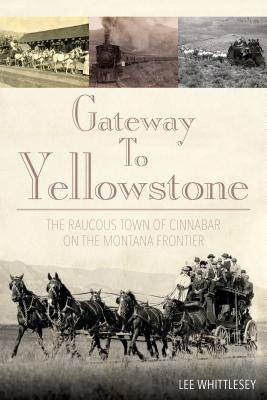
- Afhalen na 1 uur in een winkel met voorraad
- Gratis thuislevering in België vanaf € 30
- Ruim aanbod met 7 miljoen producten
- Afhalen na 1 uur in een winkel met voorraad
- Gratis thuislevering in België vanaf € 30
- Ruim aanbod met 7 miljoen producten
Zoeken
Gateway to Yellowstone
The Raucous Town of Cinnabar on the Montana Frontier
Lee Whittlesey, Lee H Whittlesey
Paperback | Engels
€ 20,95
+ 41 punten
Omschrijving
By 1883 when the rail lines of the Northern Pacific reached the tiny town of Cinnabar, Montana Territory, newspaper and magazine stories of the wonders to be found in Yellowstone National Park had been firing the imaginations of eager potential visitors around the world for a decade. Once the railroad completed that critical bit of their route, the world was poised to actually see the magic of Yellowstone, and the prospect of a trip was no longer just exciting--it was a possibility. It seemed like everyone who could afford the ticket--from middle class residents of New York City to Army Generals William Tecumseh Sherman and Philip Sheridan to President Chester A. Arthur--wanted to ride the train to see Yellowstone . Their jumping off point for their journey into "Wonderland" was the town envisioned by Hugo Hoppe, a raucous Wild West town poised for greatness as the Gateway to all of Yellowstone's offerings. The town of Cinnabar, Montana, no longer exists, but when it did, it served as the immediate railroad gateway for a generation of visitors to Yellowstone National Park. Visitors passed through its streets from September 1, 1883, through June 15, 1903 This book tells the story of its place in the West, and the legend of the town and its promoters. Its story is one of aspiration and dreams in the American West and its place in the legend and lore of Yellowstone has kept the spirit of Cinnabar alive for more than a hundred years since the town itself faded away.
Specificaties
Betrokkenen
- Auteur(s):
- Uitgeverij:
Inhoud
- Aantal bladzijden:
- 336
- Taal:
- Engels
Eigenschappen
- Productcode (EAN):
- 9781493010660
- Verschijningsdatum:
- 1/03/2015
- Uitvoering:
- Paperback
- Formaat:
- Trade paperback (VS)
- Afmetingen:
- 152 mm x 229 mm
- Gewicht:
- 408 g

Alleen bij Standaard Boekhandel
+ 41 punten op je klantenkaart van Standaard Boekhandel
Beoordelingen
We publiceren alleen reviews die voldoen aan de voorwaarden voor reviews. Bekijk onze voorwaarden voor reviews.











